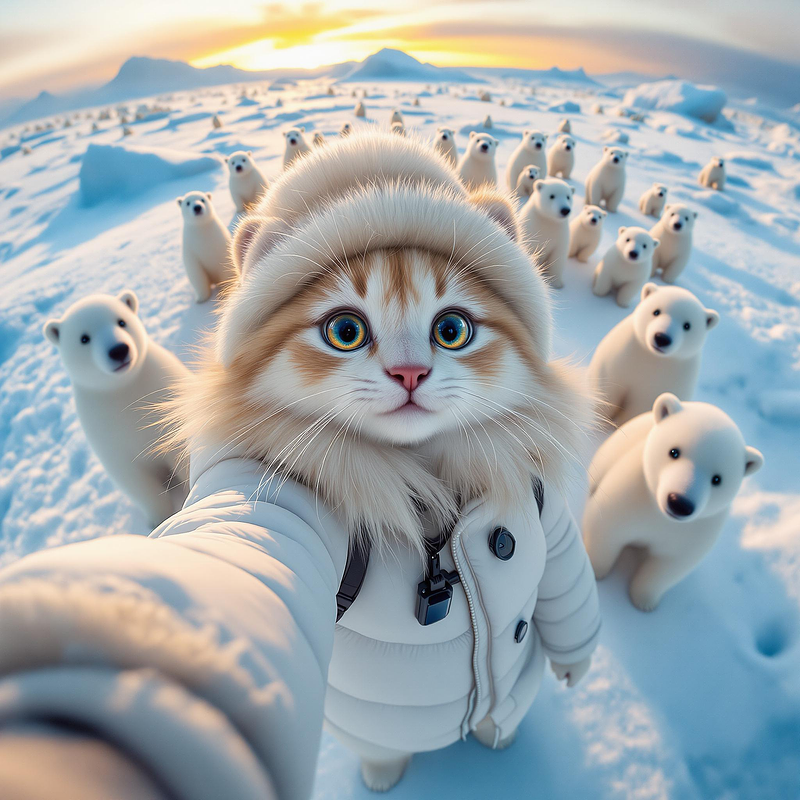


8 months ago
anthropomorphic, a cat named In the snow, there is an ice field with many polar bears standing on it. A real cute baby cat wearing a white down jacket and hat takes a selfie with gopro in front of them. The cat has big eyes, long fur, surrounded by more than ten small white polar bears, in the style of sunset light, hyper detailed

9 months ago
In the snow, there is an ice field with many mice standing on it. A real cute persian cat wearing gucci sunglasses and crocodile leather jacket and cowboy hat takes a selfie in front of them. The cat has big blue eyes, long grey fur, surrounded by more than ten small white mice, in the style of sunset light, hyper detailed

8 months ago
In the snow, there is an ice field with many mice standing on it. A real cute persian cat wearing SKI MASK and SNOW jacket and WOLLY hat takes a selfie in front of them. The cat has big blue eyes, long grey fur, surrounded by more than ten small white mice, in the style of sunset light, hyper detailed

8 months ago
On the snow is an ice field with a lot of seals standing on it. A cute gray cat in a brown down jacket is taking selfies in front of them. The cat has big green eyes, long fur, she is surrounded by more than ten little seals, done in sunset light style, hyper-detailed
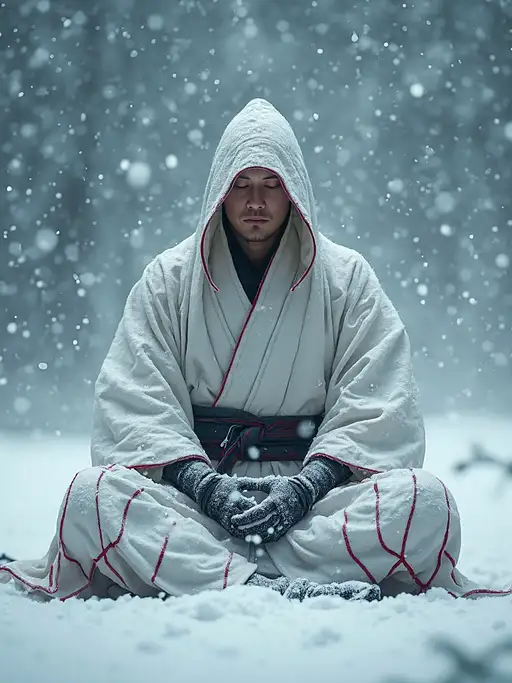
3 months ago
A hyper-realistic, cinematic image of a lone ninja sitting in deep meditation amidst a violent blizzard, his body partially covered by layers of snow. Dressed in traditional Japanese white clothing with red stitching along the outer edges (white clothing with red stitching:1.5), the ninja sits cross-legged, his posture calm and unyielding despite the fierce winds and cold. His eyes are closed, and his expression reflects deep inner focus, as though he is completely at peace with the chaotic storm around him. The snowfall is relentless, and over time, it has begun to pile up around him, covering his legs, shoulders, and the folds of his clothing (snow covering ninja:1.4). His stillness has allowed the snow to gather on him, giving the appearance of him becoming one with the environment, a figure of tranquility amidst the violent storm. His skin glistens with frost, but he seems unaffected by the freezing temperatures, radiating a quiet strength. The blizzard rages on, with snow and ice particles swirling wildly in the air, carried by the fierce winds (swirling snow and ice:1.5). The ninja's white clothing almost blends into the snow-covered ground, while the red stitching subtly stands out, drawing the eye to the intricate details of his outfit. Volumetric light beams break through the storm, casting soft, ethereal glows on the ninja and the snow beneath him, creating a mystical, dreamlike atmosphere (volumetric light in blizzard:1.4). The snowflakes catch the light as they fall, creating a shimmering effect that contrasts beautifully with the ninja’s still figure. The overall color palette features cold, muted tones of pale blues and whites, emphasizing the harshness of the environment, while the red stitching on the ninja’s clothing provides a stark, minimal contrast. The scene feels almost timeless, as if the ninja has transcended the physical world, achieving a state of complete calm and mastery over the elements." Key Elements and Weights: Ninja in White Clothing with Red Stitching: The ninja wears traditional white clothing with red stitching along the edges, sitting in a meditative pose, undisturbed by the storm (white clothing with red stitching:1.5). Snow Covering Ninja: The ninja is partially covered by snow, with snow piling up around his legs, shoulders, and clothing, symbolizing his stillness and deep focus (snow covering ninja:1.4). Blizzard with Swirling Snow: The blizzard rages on, with snow and ice particles swirling violently through the air, contrasting with the ninja’s stillness (swirling snow and ice:1.5). Volumetric Light in Blizzard: Volumetric light beams cut through the storm, casting a soft glow on the ninja and the snow, enhancing the scene's ethereal and serene atmosphere (volumetric light in blizzard:1.4). Cold Color Palette with Red Accents: The color palette is dominated by cold, muted tones of pale blues and whites, with the red stitching on the ninja’s outfit providing a minimal but striking contrast (cold blues and whites:1.4). Visual Impact: The snow-covered ninja remains calm and still, allowing the snow to gather around him, a symbol of his complete control over his mind and body despite the harsh elements. The white clothing with red stitching subtly contrasts with the snow and storm, making the ninja blend with his environment while still standing out in the details. The blizzard creates a dynamic and chaotic background, but the ninja's serene posture serves as the focal point of the scene, exuding tranquility and spiritual strength. The volumetric light beams add a mystical, dreamlike quality to the scene, creating depth and atmosphere as they interact with the swirling snow. The overall color palette, dominated by cold tones with the occasional flicker of red stitching, enhances the feeling of isolation and calm in the midst of the chaotic storm.
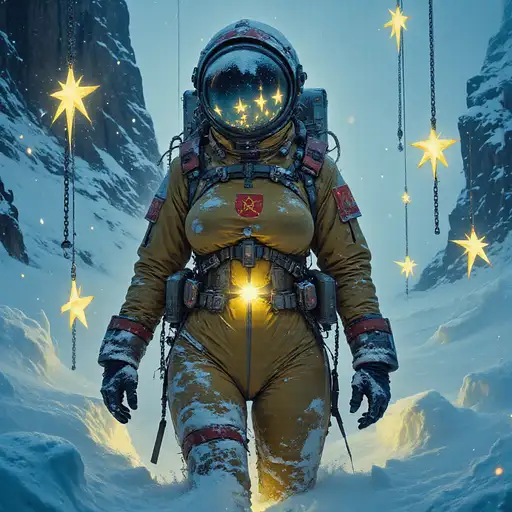
3 months ago
(A hyper-realistic, masterpiece-level color photograph:1.3) of a woman in a Soviet-style retrofuturistic spacesuit (Soviet retrofuturism:1.5) standing in the icy expanse of the Arctic during a fierce blizzard (blizzard in the Arctic:1.4). The woman’s suit, weathered and bulky, bears the clear red insignia of CCCP across the chest (CCCP insignia:1.5), adding to the harsh, militaristic aesthetic of the scene. The spacesuit has a Cold War-era design, with bold red accents and a heavy, utilitarian build, blending the futuristic with the gritty, industrial style of the Soviet Union. Surrounding her, several small, glowing stars float tethered by thick industrial chains (tethered glowing stars in a blizzard:1.4). These stars cut through the blizzard, casting yellow light that glows eerily against the swirling snow. The stars, connected to the icy ground by chains, sway violently in the wind, their light creating dynamic volumetric beams as they fight against the storm. The woman’s helmet visor reflects the glowing stars and the chaos of the blizzard around her, casting intricate patterns of light across her suit, which is half-covered in snow and ice. The volumetric lighting from the stars pierces the thick snowstorm, illuminating the drifting snowflakes and casting long, dramatic shadows across the snowy landscape. The environment is harsh and unforgiving—her spacesuit is covered in frost, and the cold, biting wind whips at her, while snow drifts build up around her legs. The blizzard creates an intense sense of motion, with the snow swirling around in unpredictable patterns, making it feel as though the woman is standing in the heart of a Soviet Arctic research mission gone wrong. Amidst the storm, the CCCP insignia glows faintly under the light of the stars, a symbol of the lost Soviet expedition. The glowing stars and industrial chains are tethered to the icy ground, creating a surreal, otherworldly scene in the middle of this brutal landscape. The scene is a combination of retrofuturistic design and gritty realism, with the harshness of the blizzard contrasting against the surreal glow of the stars. The intense lighting from the stars and the complex shadows they cast against the swirling snow create a dramatic, cinematic atmosphere. The overall mood is cold, brutal, and haunting, capturing a moment of isolation and survival in the Soviet retrofuturistic Arctic wasteland

8 months ago
Epic dark fantasy oil painting capturing the raw, mythological power of Thor, the Norse god of thunder. The setting is a wild, snowy Scandinavian landscape engulfed in a fierce blizzard, with snow whipping across the scene in chaotic gusts. The stormy sky is thick with heavy clouds, nearly obscuring the distant mountains, and cast in deep, moody blues and grays. Thor is seen from a low angle, making him appear larger-than-life and truly god-like, towering over the viewer with an aura of unstoppable strength. His powerful, muscular frame is emphasized by his pose, legs planted firmly in the deep snow as he raises Mjölnir, his legendary battle hammer, high into the turbulent sky. He is fierce and resolute, his hair and fur-lined cloak whipping wildly in the freezing wind. A massive bolt of lightning crashes down from the storm clouds, connecting with Mjölnir and bathing Thor in a blazing, blue-white glow that pierces through the blizzard. The intense light highlights his rugged features and casts dramatic shadows across his face and armor, giving him a godly, otherworldly presence. The lightning arcs around him, crackling with raw energy as snow and ice are blasted into the air from the sheer force. Thor’s attire is inspired by traditional Norse mythology, with a thick fur cloak, leather armor reinforced with metal, and sturdy boots fit for a winter warrior. His gaze is fierce, and his entire posture exudes strength and defiance against the raging storm. The color palette is cold and intense, dominated by icy blues, sharp whites, and deep shadows. The lightning illuminates Thor in a spectral light, creating a sharp contrast against the darkness of the blizzard. Snow swirls violently in every direction, caught in the powerful light, adding dynamic movement and depth to the scene. Every detail is meticulously rendered: the rippling muscles, the coarse texture of Thor’s fur cloak, the chaotic streaks of lightning, and the fierce, swirling snow. The composition conveys the raw, untamed power of the Norse god, capturing the viewer’s attention with the overwhelming force of mythic heroism and natural fury.

9 months ago
Create an ultra-realistic UHD 4K image of Lord Shiva in an intense and dramatic scene, where he is seated on the edge of a turbulent, mystical sea. His muscular, blue-hued body radiates divine energy, and his expression is filled with pain and determination. Shiva is drinking the poisonous water from the ocean with his palms held out, his hands cupped as he gathers the dark, toxic liquid. His throat is strained as he consumes the poison, symbolizing his self-sacrifice to save the universe. The poison itself is a deep, dark blue hue, almost black, swirling around him with an ethereal, sinister glow. The water around him churns with violent waves, filled with serpents, their bodies writhing and coiling around him, adding an element of danger and mystery. The snakes’ scales glisten with a dark sheen, their eyes glowing ominously as they accompany Shiva’s sacrifice. Behind Shiva, a massive mountain looms—its jagged, craggy peaks piercing the sky. From the top of the mountain, blue-dark poison is flowing down like a volcano erupting, spewing streams of poisonous liquid that pour down into the sea below. The poison flows with terrifying force, and the sky above is filled with dark clouds, adding to the scene’s ominous and cosmic tone. The volcano-like eruption of poison seems to mirror Shiva’s internal struggle as he drinks it to protect the world. Next to Shiva, his massive trident, the Trishula, is planted firmly into the ground. The trident’s three prongs are sharp and detailed, each gleaming with divine power. It stands as a symbol of his strength and the balance of creation, preservation, and destruction. The trident’s power seems to pulse with the dark energy surrounding Shiva. Shiva’s face is a mix of agony and resolve, his third eye slightly open, reflecting the cosmic energy and his pain. His matted hair flows wildly in the poisonous wind, and his body language conveys both the immense strength required to hold the poison and the suffering he endures to protect the world. His skin has a slightly glowing blue hue, even in the midst of the darkness, symbolizing his divine essence in contrast to the poison he absorbs. The entire scene is bathed in a dark, eerie light that highlights the chaos of the surroundings, with the poison flowing through the landscape. Snow and ice might be visible on the mountain’s lower slopes, contrasting with the fiery eruption of dark poison flowing down from above. The air is thick with tension and divinity, and the atmosphere is heavy with a sense of sacrifice. Textures should be detailed: the poison’s smooth yet dangerous texture, the gleam of the snakes' scales, the intricate designs on Shiva’s body and Trishula, and the raw emotion in his facial expression. The background, with the volcano-like eruption and swirling dark waters, should be equally intricate, filled with chaotic, yet beautiful, contrast.
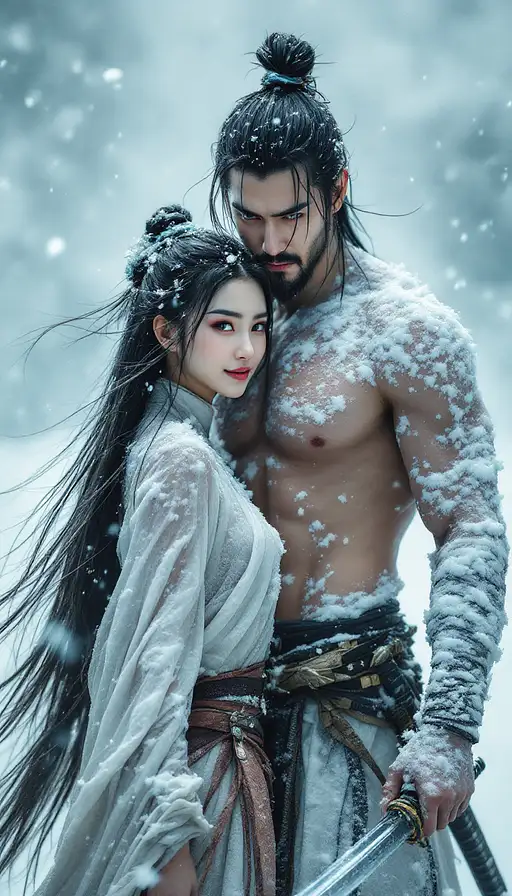
6 months ago
A surreal movie scene, a Chinese ninja and a stunning beauty standing in a fierce snowstorm, the Chinese ninja holding a samurai sword, his body partially covered by layers of snow. The ninja is only wearing a traditional Japanese undergarment (minimalist underwear), and his exposed skin is covered by frost and snow (traditional undergarment: 1.5). The stunning beauty has long flowing hair. Two people, a surreal movie scene. A Chinese ninja and a stunning Chinese beauty stand in a fierce snowstorm. The Chinese ninja holds a samurai sword in his hand, and his body is partially covered by layers of snow. The ninja wears only traditional Japanese undergarments (minimalist underwear), and his bare skin is covered by frost and snow (traditional undergarments: 1.5). The stunning beauty, with long flowing hair, smiles. The overall color palette is dominated by cold tones of pale blues, whites, and icy grays, emphasizing the harshness of the environment. The ninja’s calm, minimal appearance in traditional fundoshi adds to the sense of serenity amidst the chaos, as though he has transcended the physical world and become one with the elements." Key Elements and Weights: Ninja in Traditional Fundoshi: The ninja is dressed only in traditional Japanese underwear (fundoshi), sitting in a meditative pose amidst the blizzard, with his body partially exposed to the cold (traditional fundoshi:1.5). Snow Covering Ninja: The snow has started to cover the ninja's shoulders, arms, and legs, symbolizing his stillness and deep focus (snow covering ninja:1.4). Blizzard with Swirling Snow: The blizzard rages on, with snow and ice particles swirling through the air, contrasting with the ninja’s calm posture (swirling snow and ice:1.5). Volumetric Light in Blizzard: Volumetric light beams cut through the storm, casting soft, ethereal glows on the ninja and the snow, adding depth and atmosphere (volumetric light in blizzard:1.4). Cold Color Palette: The scene is bathed in cold tones of pale blues, whites, and icy grays, enhancing the harshness of the environment and the sense of isolation (cold blue tones:1.4).
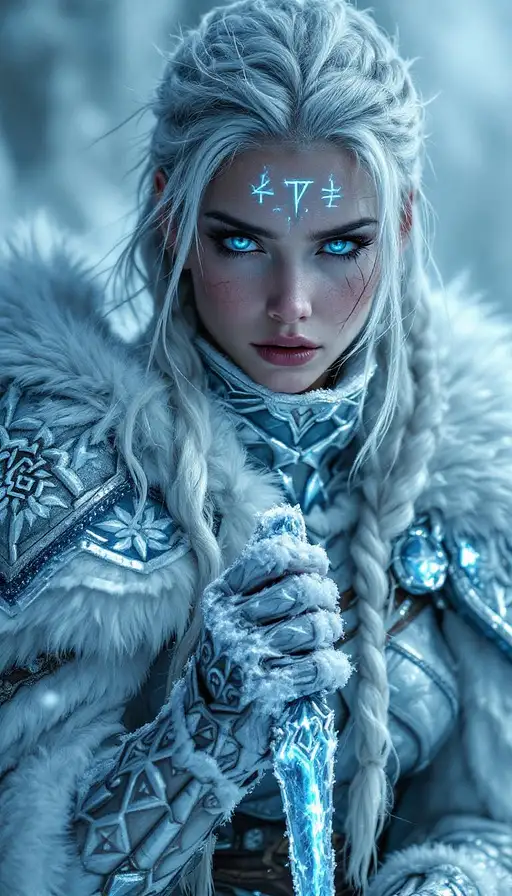
4 months ago
Incredibly beautiful Norwegian with blue eyes, beautiful blue eyes, with perfect iriseslong eyelashes, black eyeliner, freckles. A cinematic digital artwork featuring a resilient, female frost warrior in a resolute yet weary, battle-hardened pose, set against a desolate, ice-covered, arctic backdrop with a cold, glacial blue glow. The subject, a humanoid character with long, braided white hair and piercing, icy blue eyes, embodies a fusion of elemental power and warrior spirit. The intricate, silver and ice-blue armor, with a crystalline, frost-like texture, covers the entire body except for the face, which is partially visible, wind-chapped and marked by faint, glowing blue frost patterns on the forehead and cheekbones. A tattered, white fur cloak with a prominent, stylized frost rune on the shoulder adds to the harsh, arctic atmosphere. In their right hand, they grip a cracked, frost-covered greats word, pointing downward, surrounded by a swirling mist of ice crystals, casting sharp, icy shadows on the frozen surroundings. The background is a vast expanse of cracked ice, jagged ice formations, and snow-covered mountains, with hints of blizzards and strong winds, amplifying the sense of isolation and elemental power. The lighting is focused on the character, emphasizing the textures of the armor, creating a sense of depth and chilling realism, a playfully shy look. Perfect white teeth.

6 months ago
A photorealistic landscape photograph of a majestic snow-capped mountain peak against a vibrant blue sky with fluffy white clouds. The mountain has steep rocky faces with patches of snow and ice, and a dramatic triangular shape. In the foreground, a stream flows over dark rocks, creating white water splashes. The stream is surrounded by a lush meadow filled with pink and white daisies in full bloom. The meadow extends towards the base of the mountain, creating a natural frame for the scene. The mountain's base is partially obscured by green rolling hills and valleys. The lighting creates a soft glow on the mountain's face, with shadows falling into the valleys. The composition is shot in high dynamic range, capturing both the bright sky and detailed shadows in the mountain's crevices. The overall image has rich, saturated colors and a dreamlike quality, with the flowers in the foreground creating a natural vignette effect.

8 months ago
anthropomorphic, a cat named In the snow, there is an ice field with many polar bears standing on it. A real cute baby cat wearing a white down jacket and hat takes a selfie with gopro in front of them. The cat has big eyes, long fur, surrounded by more than ten small white polar bears, in the style of sunset light, hyper detailed

8 months ago
In the snow, there is an ice field with many mice standing on it. A real cute persian cat wearing SKI sunglasses and PUFFY WINTER jacket and WOLLY hat takes a selfie in front of them. The cat has big blue eyes, long grey fur, surrounded by more than ten small white mice, in the style of sunset light, hyper detailed

8 months ago
In the snow, there is an ice field with many mice standing on it. A real cute persian cat wearing SKI sunglasses and NORTHFACE PUFFER JACKET jacket and WOLLY HAT takes a selfie in front of them. The cat has big blue eyes, long grey fur, surrounded by more than ten small white mice, in the style of sunset light, hyper detailed

5 months ago
Create a meticulously staged cinematic scene with rigid symmetry and frontal, low-angle framing, emphasizing a diagonal composition (45-degree tilt) where all elements align along a single dynamic axis. Color Grading: 60% Dominant: Soft, powdery pastel pinks (Pantone 12-1109 TPX "Marshmallow") saturating the sky, snow, and TV casing. 30% Secondary: Frosted teal blues (HEX #6ECEDA) in the glacial lake, aurora, and TV screen static. 10% Accent: Mustard-yellow (Pantone 15-0950 TPX "Golden Glow") in the aurora streaks, wool tufts, and corroded metal knobs. TV Design: A 1950s Bakelite TV (matte eggshell plastic with hairline cracks) tilted diagonally (top-left corner at 10 o’clock, bottom-right submerged at 4 o’clock). Crack: A jagged diagonal fissure (2cm wide) splits the screen from top-left to bottom-right, leaking viscous, neon-bright color bar pigment (RGB values: pink #FF9EB5, teal #5FDAC3, gold #FFD700) that pools into the water below. Materials: Body: Faux-weathered plastic with chipped edges revealing rusted steel underlayers. Details: Three rotary knobs (tarnished brass, 4cm diameter) labeled "VOL," "TUNE," "POWER." Cables: Braided wool cords (undyed cream yarn, 3cm thickness) coiled around the TV’s base, fraying at the ends. Screen Imagery: Static Overlay: A 1953 RCA-style color bar test pattern (8 vertical bands) glitching every 2 seconds, causing the teal and pink bars to "melt" downward into liquid the word "Imagen-4" glitches on the screen Underlying Image: A faint, glowing topographical map (golden-yellow lines on indigo) dissolves into water that cascades from the screen’s crack, merging with the glacial lake. Environment: Glacial Lake: Semi-frozen water (translucent teal, 70% opacity) with jagged ice shards (20cm height) encircling the TV. Snowfall: Heavy, dense snowflakes (1cm diameter) falling at 45 degrees, accumulating on the TV’s top-left corner. Aurora Borealis: Three parallel bands (pink #FFB3D1, teal #7FE5E5, gold #FFE44D) in smooth sine waves, 15° tilt, 80% opacity. Sky: Ultra-high-contrast starfield (ISO 51200 noise pattern) with 2,000 visible stars (randomized 2-4px white dots). Lighting & Effects: Key Light: A frontal, low-orange sodium vapor lamp (3200K) casting sharp diagonal shadows (20° angle) from the TV onto the ice. Bloom: Halation around the aurora and screen, radius 15px, intensity 70%. Textures: Film Grain: 35mm Kodak Vision3 250D overlay (gritty, high-detail). Lens Defects: Two hairline scratches (1px width) at 15° and 75° angles, plus hexagonal lens flare (60% opacity) from the aurora. Physics & Motion: Water: Viscous fluid dynamics—the leaking color bars swirl in 5cm eddies, blending with the glacial lake. Wool: Submerged yarn floats upward in 10cm tufts, swaying at 0.5Hz frequency. Result: A hyper-detailed, reference-free scene that implicitly channels Wes Anderson’s aesthetic through obsessive symmetry, retro-kitsch materials, and a strict 60/30/10 pastel hierarchy—no director named, all style embedded in granular technical specs.

5 months ago
"Create a meticulously staged cinematic scene with rigid symmetry and frontal, low-angle framing, emphasizing a diagonal composition (45-degree tilt) where all elements align along a single dynamic axis. Color Grading: 60% Dominant: Soft, powdery pastel pinks (Pantone 12-1109 TPX "Marshmallow") saturating the sky, snow, and TV casing. 30% Secondary: Frosted teal blues (HEX #6ECEDA) in the glacial lake, aurora, and TV screen static. 10% Accent: Mustard-yellow (Pantone 15-0950 TPX "Golden Glow") in the aurora streaks, wool tufts, and corroded metal knobs. TV Design: A 1950s Bakelite TV (matte eggshell plastic with hairline cracks) tilted diagonally (top-left corner at 10 o’clock, bottom-right submerged at 4 o’clock). Crack: A jagged diagonal fissure (2cm wide) splits the screen from top-left to bottom-right, leaking viscous, neon-bright color bar pigment (RGB values: pink #FF9EB5, teal #5FDAC3, gold #FFD700) that pools into the water below. Materials: Body: Faux-weathered plastic with chipped edges revealing rusted steel underlayers. Details: Three rotary knobs (tarnished brass, 4cm diameter) labeled "VOL," "TUNE," "POWER." Cables: Braided wool cords (undyed cream yarn, 3cm thickness) coiled around the TV’s base, fraying at the ends. Screen Imagery: Static Overlay: A 1953 RCA-style color bar test pattern (8 vertical bands) glitching every 2 seconds, causing the teal and pink bars to "melt" downward into liquid with the word "Prompthero" barely visible on it. Underlying Image: A faint, glowing topographical map (golden-yellow lines on indigo) dissolves into water that cascades from the screen’s crack, merging with the glacial lake. Environment: Glacial Lake: Semi-frozen water (translucent teal, 70% opacity) with jagged ice shards (20cm height) encircling the TV. Snowfall: Heavy, dense snowflakes (1cm diameter) falling at 45 degrees, accumulating on the TV’s top-left corner. Aurora Borealis: Three parallel bands (pink #FFB3D1, teal #7FE5E5, gold #FFE44D) in smooth sine waves, 15° tilt, 80% opacity. Sky: Ultra-high-contrast starfield (ISO 51200 noise pattern) with 2,000 visible stars (randomized 2-4px white dots). Lighting & Effects: Key Light: A frontal, low-orange sodium vapor lamp (3200K) casting sharp diagonal shadows (20° angle) from the TV onto the ice. Bloom: Halation around the aurora and screen, radius 15px, intensity 70%. Textures: Film Grain: 35mm Kodak Vision3 250D overlay (gritty, high-detail). Lens Defects: Two hairline scratches (1px width) at 15° and 75° angles, plus hexagonal lens flare (60% opacity) from the aurora. Physics & Motion: Water: Viscous fluid dynamics—the leaking color bars swirl in 5cm eddies, blending with the glacial lake. Wool: Submerged yarn floats upward in 10cm tufts, swaying at 0.5Hz frequency. Result: A hyper-detailed, reference-free scene that implicitly channels Wes Anderson’s aesthetic through obsessive symmetry, retro-kitsch materials, and a strict 60/30/10 pastel hierarchy—no director named, all style embedded in granular technical specs.

8 months ago
(A hyper-realistic, cinematic photograph in the style of 1970s Soviet sci-fi:1.3), depicting a lone Soviet Arctic explorer struggling through an intense blizzard (flying snow particles:1.7) as the setting sun (setting sun through blizzard:1.5) tries to pierce through the swirling storm. The explorer is clad in a bulky, worn, and weathered retro-futuristic spacesuit, with faded red and white accents and a prominently displayed CCCP insignia across the chest (CCCP insignia:1.5). His suit is covered in frost and ice, battered by the harsh Arctic conditions, with snow clinging to the edges and joints. The blizzard is fierce, with snow and ice particles violently flying through the air (flying snow particles:1.7), obscuring the landscape and making the explorer’s journey even more treacherous. The air is thick with whipping snow, which interacts with the faint light from the setting sun (sunlight piercing through storm:1.5), casting dim, golden beams that struggle to penetrate the storm. The light creates fleeting, volumetric shafts through the blizzard, catching on the swirling snowflakes and illuminating the scene in brief, ghostly flashes. Despite the fading light and harsh conditions, the explorer presses on toward a barely visible nuclear generator (nuclear generator:1.4), half-buried under the snow. His steps are slow and heavy, with snow building up around his legs as he fights against the wind. The worn spacesuit shows signs of prolonged use, with cracks in the visor fogging over, and his breath visible inside the helmet. Snow particles whip violently around him, catching the last of the day’s light, while patches of golden sunlight filter through the blizzard, giving a surreal and fleeting glow to the harsh, frozen landscape. The setting sun casts long, dramatic shadows across the snow-covered ground, but the intensity of the storm continually threatens to snuff out the light, making the environment feel overwhelming and unforgiving. The blizzard is relentless, with snow and ice clinging to the explorer’s spacesuit, and the setting sun adds a feeling of urgency, as if time is running out. The last beams of sunlight interact with the flying snow particles, creating a flickering effect, with the light constantly shifting and fading as the explorer marches forward.
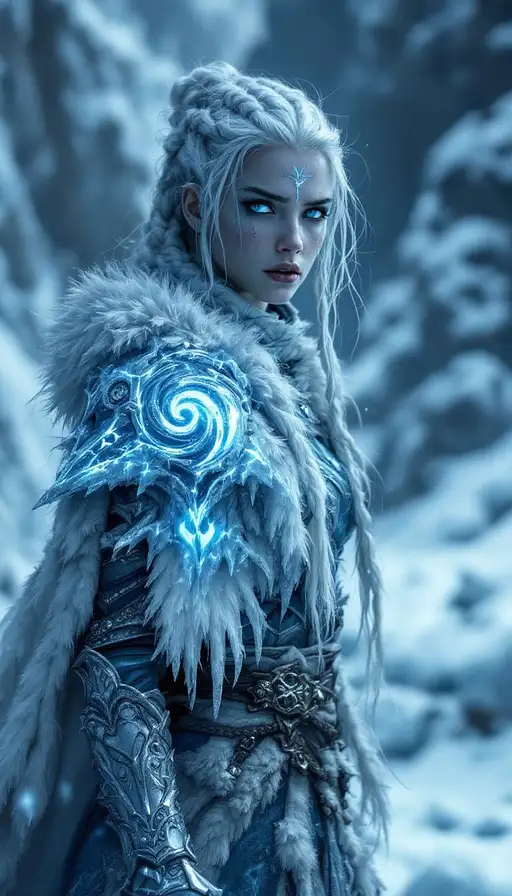
2 months ago
A cinematic digital artwork featuring a resilient, female frost warrior in a resolute yet weary, battle-hardened pose, set against a desolate, ice-covered, arctic backdrop with a cold, glacial blue glow. The subject, a humanoid character with long, braided white hair and piercing, icy blue eyes, embodies a fusion of elemental power and warrior spirit. The intricate, silver and ice-blue armor, with a crystalline, frost-like texture, covers the entire body except for the face, which is partially visible, wind-chapped and marked by faint, glowing blue frost patterns on the forehead and cheekbones. A tattered, white fur cloak with a prominent, stylized frost rune on the shoulder adds to the harsh, arctic atmosphere. In their right hand, they grip a cracked, frost-covered greatsword, pointing downward, surrounded by a swirling mist of ice crystals, casting sharp, icy shadows on the frozen surroundings. The background is a vast expanse of cracked ice, jagged ice formations, and snow-covered mountains, with hints of blizzards and strong winds, amplifying the sense of isolation and elemental power. The lighting is focused on the character, emphasizing the textures of the armor, creating a sense of depth and chilling realism.

6 months ago
: (Ultra-detailed, Boris Vallejo, hyper-realistic, cinematic, sharp focus:1.5), He-Man, the iconic hero, stands triumphantly in the midst of a raging ice storm. He holds his sword high above his head, as if proclaiming, "I have the power," with lightning crackling around the blade. His muscular, powerful body is accentuated by Vallejo's dynamic style, showing off his strength and determination. He-Man's expression is fierce and focused, his eyes glowing with intense energy as he channels the mystical power of his sword. His bare, muscular torso glistens with frost, with snow clinging to his skin and fur loincloth, while his boots and gauntlets are adorned with ice crystals. His sword gleams with a cold, icy light, radiating power that pierces through the blizzard. The storm swirls violently around him, with snow and ice particles at varying depths, creating a rich sense of movement and depth. (Volumetric lighting) from the storm casts dynamic shadows across his well-defined, muscular form, while the cold, blue hues of the blizzard contrast with the glowing energy of the sword. In the background, jagged ice formations loom, and the storm’s chaos is enhanced by Vallejo’s signature vibrant colors and (hand-drawn, raw texture:1.5). He-Man’s pose is iconic, exuding power and determination, standing strong against the storm as the embodiment of heroic strength. Key Focus: (Perfect anatomy definition:1.5) for muscular, well-shaped body details. (Clear edges:1.5) to ensure his silhouette stands out sharply against the storm. (Realistic face:1.5) for a detailed and heroic facial expression. (Volumetric lighting:1.5) to enhance the storm and sword’s glow, adding depth and atmosphere. (Cinematic, hand-painted:1.5) look to maintain the classic Vallejo fantasy style with a modern, realistic twist.

6 months ago
A photorealistic landscape photograph of a majestic snow-capped mountain peak against a vibrant blue sky with fluffy white clouds. The mountain has steep rocky faces with patches of snow and ice, and a dramatic triangular shape. In the foreground, a stream flows over dark rocks, creating white water splashes. The stream is surrounded by a lush meadow filled with pink and white daisies in full bloom. The meadow extends towards the base of the mountain, creating a natural frame for the scene. The mountain's base is partially obscured by green rolling hills and valleys. The lighting creates a soft glow on the mountain's face, with shadows falling into the valleys. The composition is shot in high dynamic range, capturing both the bright sky and detailed shadows in the mountain's crevices. The overall image has rich, saturated colors and a dreamlike quality, with the flowers in the foreground creating a natural vignette effect.
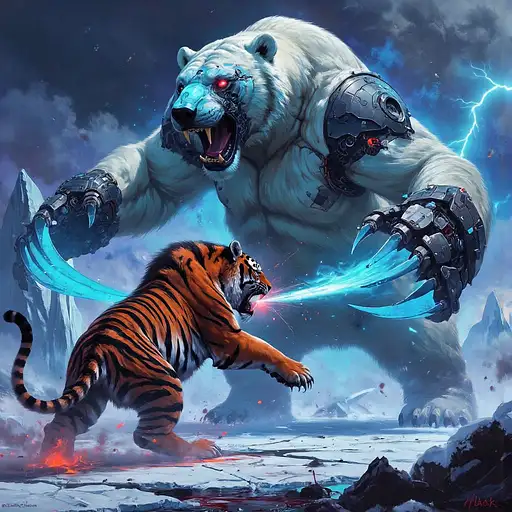
9 months ago
A ferocious and cinematic battle unfolds amidst a raging blizzard, where a towering 6-meter-tall battle polar bear clashes with an equally massive and enhanced battle tiger. The polar bear, standing on its hind legs, roars with primal fury, its blue robotic eye glowing through the swirling snow. Its massive steel claws gleam as they swipe downward in a savage attack, creating arcs of reflected light in the chaos. Deep scars and patches of armor plating cover its snow-white fur, the cold wind whipping around its hulking frame. Opposing the bear, the tiger, equally enormous, crouches low before springing into a powerful leap. Its fiery orange fur, streaked with black stripes and plated with patches of reinforced armor, contrasts starkly against the icy landscape. The tiger’s glowing red cybernetic eye locks onto the bear, its enhanced steel claws extending mid-strike as it lunges forward with ferocious intent. Steam rises from its breath, visible in the freezing air, as the two titanic creatures engage in brutal combat. The blizzard intensifies around them, with thick waves of snow and ice partially obscuring their forms, creating a dynamic and chaotic atmosphere. The icy ground beneath them is cracked and shattered, marked by streaks of crimson and claw marks, evidence of the relentless violence of their battle. Behind them, jagged ice formations loom in the distance, barely visible through the storm. The lighting is cinematic, with flashes of distant lightning illuminating the clash. The glow of the polar bear’s blue robotic eye and the tiger’s red cybernetic eye cut through the darkness, adding a futuristic edge to their primal fury. The bear’s steel claws reflect cold, silvery light, while the tiger’s metallic enhancements gleam with a faint orange hue, emphasizing their cybernetic power.
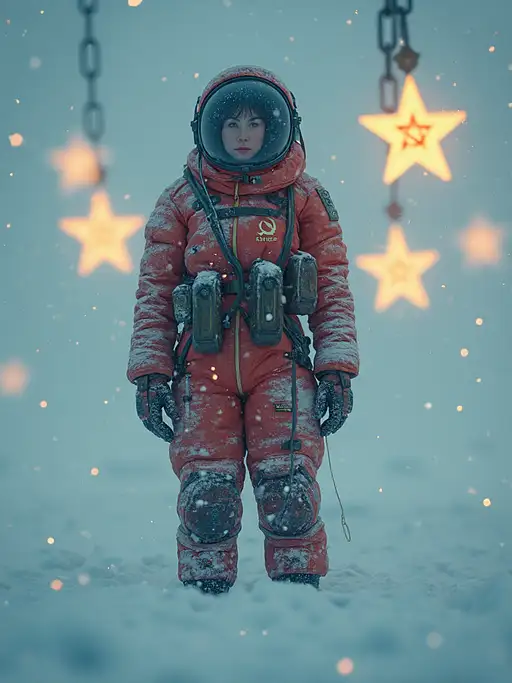
3 months ago
(A hyper-realistic, masterpiece-level color photograph:1.3) of a woman in a Soviet-style retrofuturistic spacesuit (Soviet retrofuturism:1.5) standing in the icy expanse of the Arctic during a fierce blizzard (blizzard in the Arctic:1.4). The woman’s suit, weathered and bulky, bears the clear red insignia of CCCP across the chest (CCCP insignia:1.5), adding to the harsh, militaristic aesthetic of the scene. The spacesuit has a Cold War-era design, with bold red accents and a heavy, utilitarian build, blending the futuristic with the gritty, industrial style of the Soviet Union. Surrounding her, several small, glowing stars float tethered by thick industrial chains (tethered glowing stars in a blizzard:1.4). These stars cut through the blizzard, casting yellow light that glows eerily against the swirling snow. The stars, connected to the icy ground by chains, sway violently in the wind, their light creating dynamic volumetric beams as they fight against the storm. The woman’s helmet visor reflects the glowing stars and the chaos of the blizzard around her, casting intricate patterns of light across her suit, which is half-covered in snow and ice. The volumetric lighting from the stars pierces the thick snowstorm, illuminating the drifting snowflakes and casting long, dramatic shadows across the snowy landscape. The environment is harsh and unforgiving—her spacesuit is covered in frost, and the cold, biting wind whips at her, while snow drifts build up around her legs. The blizzard creates an intense sense of motion, with the snow swirling around in unpredictable patterns, making it feel as though the woman is standing in the heart of a Soviet Arctic research mission gone wrong. Amidst the storm, the CCCP insignia glows faintly under the light of the stars, a symbol of the lost Soviet expedition. The glowing stars and industrial chains are tethered to the icy ground, creating a surreal, otherworldly scene in the middle of this brutal landscape. The scene is a combination of retrofuturistic design and gritty realism, with the harshness of the blizzard contrasting against the surreal glow of the stars. The intense lighting from the stars and the complex shadows they cast against the swirling snow create a dramatic, cinematic atmosphere. The overall mood is cold, brutal, and haunting, capturing a moment of isolation and survival in the Soviet retrofuturistic Arctic wasteland
